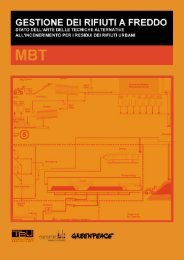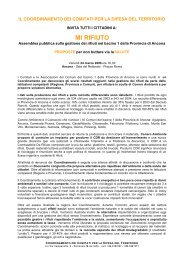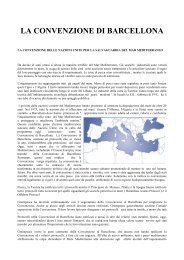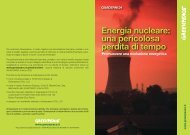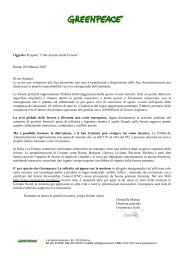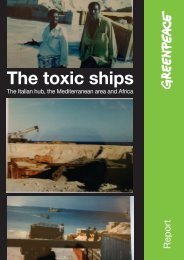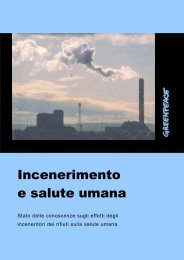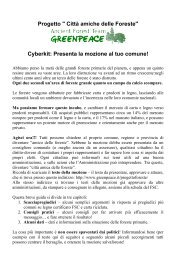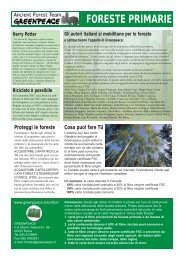Zero Waste by Robin Murray, Greenpeace Environmental Trust 2002
Zero Waste by Robin Murray, Greenpeace Environmental Trust 2002
Zero Waste by Robin Murray, Greenpeace Environmental Trust 2002
You also want an ePaper? Increase the reach of your titles
YUMPU automatically turns print PDFs into web optimized ePapers that Google loves.
(including collection and transport) of recycling are<br />
high and where the practical optimum for materials<br />
recovery has been reached.’ 80<br />
For this argument to hold, much depended on life<br />
cycle analysis as applied to particular materials, waste<br />
management methods and places. The second half of<br />
the 1990s thus saw an increasing use of these tools to<br />
determine the BPEO, largely using static LCAs, and<br />
culminating in the Environment Agency’s WISARD, a<br />
model that disposal authorities were required to use to<br />
determine the optimum mix of methods.<br />
On the basis of these three arguments, local authorities<br />
w e re encouraged to include EfW in their disposal plans and<br />
to consider the need for long-term disposal contracts as a<br />
condition for financing the large-scale investment re q u i red.<br />
All three arguments are now in question. The revelations<br />
about the operating conditions at the Byker and<br />
Edmonton incinerators, of the exceedances and the<br />
practices of ash disposal, have raised major questions<br />
about the safety of ‘actually existing incinerators’. These<br />
concerns have been compounded <strong>by</strong> the fires at the<br />
Dundee incinerator and the Wolverhampton plant, and <strong>by</strong><br />
the problems of persistent exceedances at the Coventry<br />
and Sheffield plants. 81 The precautionary principle now<br />
hangs like a cloud over the safety claims about modern<br />
incinerators as they actually operate.<br />
Secondly, the US EPA 1998 report and the idea of<br />
environmental opportunity cost would counsel prudence<br />
in arguing for EfW’s contribution to CO2 reduction,<br />
relative to recycling and composting.<br />
Similarly the critique of static LCAs and the controversy<br />
surrounding WISARD makes the concept of BPEO a less<br />
reliable support for EfW than was once thought.<br />
(ii) finance<br />
The principal practical problem for incineration has been<br />
its high cost relative to landfill, an underlying differential<br />
that has increased as emissions limits have tightened. The<br />
government – through both the former DETR and the DTI<br />
– has concentrated on reducing this gap. The increase in<br />
the landfill tax assisted in this. But the two ministries<br />
have, between them, provided a range of subsidies or<br />
decisions on classification that have lowered the costs of<br />
incineration.<br />
The subsidy and classification measures have included:<br />
• awards under successive tranches of the NFFO, which<br />
for the two London incinerators alone were worth £14<br />
million p.a.;<br />
• exemption of incineration from the proposed Climate<br />
Change levy;<br />
• the inclusion of pyrolysis and gasification in the<br />
Renewables Obligation;<br />
• the provision of government funds under the Private<br />
Finance Initiative;<br />
• the classification of incinerator bottom ash as inert,<br />
thus reducing the landfill tax to £2 a tonne;<br />
• the classification of incinerator ash for construction<br />
purposes as recycling (ceased 2001) and the promotion<br />
of its use as a means of reducing the costs of disposal;<br />
• the classification of energy from waste as re c o v e ry rather<br />
than disposal. (The EU Commission argued that it was<br />
disposal, on the grounds that the low thermal value of<br />
municipal solid waste did not qualify it to be considere d<br />
as a fuel.) This allowed EfW plants to issue and sell<br />
packaging re c o v e ry notes for the packaging element of<br />
their combusted waste (a pro p o rtion estimated at 19%);<br />
122<br />
<strong>Zero</strong> <strong>Waste</strong><br />
123



